


Airports Council International (ACI) World has published updated guidance for airports to aid their business recovery and improve operations following the COVID-19 pandemic.
In addition to advice on practical and efficient health and operational measures that can be introduced to support safe travel, the trade body has also expanded its guidance to include information on health passes and vaccinations, as well as risk management when returning to operations, with a particular focus on human factors during recovery.
ACI anticipates the return to business for the industry to take place in phases with mainly domestic travel recovering first with a slow increase in passenger volume. Then it is expecting a gradual scale-up in capacity based on passenger demand. This will then be followed by a return to more normal passenger volumes.
“Over the last 15 months, ACI has worked with governments, international organisations and industry partners to address the concerns of the aviation industry in an effort to mitigate the effects of the pandemic and return to a thriving and dynamic business,” said ACI World Director General, Luis Felipe de Oliveira.
“Airports have shown considerable resilience and ingenuity in developing procedures to help passengers feel safe and secure, and ACI has promoted the interests of airports in the global community, which goes well beyond aviation. The ACI Airport Health accreditation Programme is a clear example of our shared commitment to prioritised health, safety, and the customer experience, on the path to recovery.”
Oliveira also noted that with the global roll out of vaccines and loosening of travel restrictions, “the time for airport business recovery is here… The updated guidance will help airports to seize the moment. It covers all aspects oof airport management and operation to help the airport operators choose and implement measures that might be appropriate according to local circumstances.”
The publication, which is currently in its third edition, is being sponsored by Honeywell, which has also contributed new chapters on technological solutions for healthy airports





